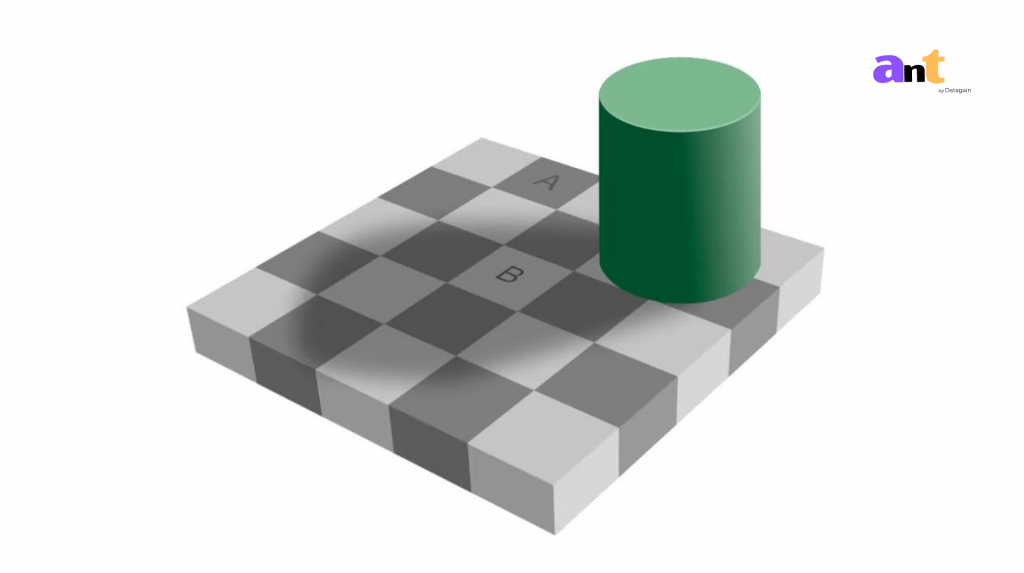
Home » Transcript Library » All Transcripts » Imperfect Perception: Illusions, Gestalt Principles of Grouping, and Language Relativism Transcript
Imperfect Perception: Illusions, Gestalt Principles of Grouping, and Language Relativism Transcript
Dave Farina 00:06
Before we can talk about how the mind works, we need to understand how the mind gets information.
Sensation, or how we acquire information about the world through our senses, is one of the building
blocks of psychology. Perception then steps in, making sense of the information received through
sensation and turning it into something useful.
00:28
We talked a lot about how sensation works in our Biopsychology series, so head back to some of those
tutorials if you need a refresher. Otherwise, put very briefly, here's what you need to know about
sensation for this psychology course. We get basic sensory information through our senses, those
being taste, touch, smell, hearing, and vision. This information comes in the form of things like light
waves, sound waves, and molecular entities. The brain then changes, or transduces, this raw
information into information that we can perceive. Perception, then, is just the brain putting sensory
information together to represent the external world. It's these mental representations that we use to
go through our daily life.
01:18
Now, there is a bunch of information out there in the world that our senses are picking up. In order to
not get overwhelmed, we actually don't perceive everything that we could at any given time. Here's an
example, think about your nose. Your nose is always in your field of vision, but our brains ignore it, so
we do not perceive it. The visual information of your nose is a sensation that our brain filters out
because it's not information that we need on a day-to-day basis.
01:49
So how does the brain decide what is necessary information and what is unnecessary? The mind uses a
number of tricks and shortcuts to process all the incoming sensory information efficiently. Take visual
perception, for example. Our minds automatically assume that things in shadow are lighter than they
actually are. As a demonstration, look at this checker shadow illusion. Square A is not in any shadow,
while square B is in the shadow of the cylinder. It looks like square B is a lighter shade of gray than
square A. But it turns out that they are actually the same color. Your mind is perceiving square B as
lighter because we automatically assume things in shadows are lighter than they actually are. But if we connect the two squares with a rectangle of the same color, we see that square A and square B are
really the same. Our minds are easily fooled by this illusion.
02:48
Another set of rules the mind uses are called Gestalt Laws of Grouping or Principles of Grouping. These
rules are a set of heuristics or shortcuts that the mind uses to group small objects into larger ones, and
they play an important role in our visual perception. The principles are proximity, similarity, closure,
good continuation, common fate, and good form. Let's take a moment to look at each of these more
closely.
03:20
The principle of proximity states that when objects are close together, the mind sees them as a single
group or object. This happens even when the objects differ in shape, size, and color, even if they don't
actually touch each other. As long as they are close to one another, the mind makes them one cohesive
object.
03:40
The principle of similarity states that we perceive objects which are physically similar to be parts of the
same object. This lets us differentiate between adjacent and overlapping objects based on their physical
characteristics. For example, if there was a large field where multiple different crops grew side-by-side,
your mind would probably group similar crops together based on their color and texture. There would
be a corn group, next to a cabbage group, next to a wheat group, and so on.
04:13
The principle of closure states that our minds tend to complete figures even if the picture is incomplete
or partially hidden by other objects. Look at this panda in the World Wildlife Fund logo. There are no
lines connecting its ears to the top of its head. Even so, your mind looks at that image and completes the
circle of the panda's head. If a shape's border is missing, we tend to see the shape as complete and
ignore the gaps entirely. This tendency allows us to recognize patterns and fill in missing
information, a skill that would be important if, say, there was a partially concealed predator nearby. We
would be able to recognize it as a predator even if we didn't see the whole thing, and react accordingly.
05:01
The next principle is good continuation. When objects intersect with each other, we perceive them as two separate objects rather than one single object. This lets us differentiate between objects as
separate entities, even if they overlap. When objects intersect, we tend to continue the contours of
each object when they have established an implied direction.
05:26
The next principle, the principle of common fate, states that we perceive visual stimulus as part of the
same overall object when they are moving in the same direction. Imagine you see a large flock of birds.
Even though there are many birds, they are seen together as a single object, a flock, because they are all
moving in the same direction and at the same speed. Even if two flocks crossed paths, we would see
them as separate objects because each flock would have a unique direction and speed.
05:59
And the final principle we use in visual perception is the principle of good form. This is our tendency to
perceive objects in the simplest way possible. Think of the Olympic symbol. We see it as overlapping
circles instead of a bunch of curved, connected lines.
06:16
The principles of grouping represent just one of the many ways our minds take visual information to
create a mental picture of the world. Remember, the main goal of sensation and perception is to give us
an internal representation of the world around us. But how accurate and objective is this
representation? As it turns out, not as perfect and accurate as one might think! We are susceptible to a
variety of visual illusions, often due to visual context and expectations.
06:48
Let's take a look at the classic illusion, the Shepard’s Table. In this illusion, there are two tables, a long
and skinny one and a fatter, almost square one. The tops of these tables are actually constructed with
two parallelograms of the exact same size! Because they are shown to us as tabletops with legs, our
brains automatically interpret them as objects in three-dimensional space. The "long and narrow" table
thus looks long and narrow because we see it as receding into the distance. If we took off the table legs,
we would stop perceiving them as three-dimensional objects and our minds would see that they are
indeed the same size. We can even prove that to ourselves by overlaying this solid on one shape and
then the other.
07:36
Our expectations also impact our visual perception. Imagine you were going for a walk in a forest where
there have been many moose sightings. You see what appears to be a moose behind a large tree, and
change directions so you don't disturb the moose. As you hike away, though, you realize that the moose
is actually just two broken tree stumps. Because of the Gestalt Law of Continuation, you perceived these
two shapes as a continuous object. Then, because you were walking in a moose-laden land, you
expected to see a moose, so that's what you saw.
08:10
In addition to being affected by visual context and expectations, our perception of things can actually be
affected by our beliefs, desires, and even culture. Language, for example, can impact how we see colors.
Language Relativism, also known as the Sapir-Whorf hypothesis, is the idea that the language we speak
constrains our perception and cognition. So, if your language doesn't have a word for the color green,
you don't see the color green. Now, this isn't as crazy as it sounds. We do have basic universals in
perception regardless of language. Infants and individuals from cultures with only terms for light and
dark are able to tell the difference between basic colors like red, green, blue, and yellow. However,
linguistic color categories, or how your language names and recognizes colors, does shape how readily
we are able to see and discriminate between colors.
09:09
Take Russian, for example. Things aren't simply blue in Russian. They are either dark blue (siniy) or light
blue (goluboy). Russian speakers are better at seeing a light blue triangle against a dark
blue background, and vice versa, than they are at identifying green triangles against green backgrounds.
German speakers, who do not have dedicated words for light blue and dark blue, are no better at seeing
blue triangles than green ones. This suggests that simply having distinct words for light blue and dark
blue changes Russian speakers' perception when confronted with shades of blue. Your language shapes
how you perceive and discriminate between colors.
09:54
Your daily life experience can also impact your perception. A study done in 2010 by Balcetis
and Dunning looked at how desire impacts perception by manipulating how thirsty participants were.
Participants were in either the thirsty group, where they ate a bowl of pretzels, or in the quenched
group, where they drank up to four glasses of water. Each participant was then asked how far away a
glass of water was. The quenched group thought the water was significantly farther away than the
thirsty group did. The desire of wanting water changed the perception of distance. This result has been
repeated in multiple studies, looking at things like probability of winning, physical tiredness, and priming
with ideas, and their effect on perception.
10:43
When participants are shown a $100 bill, they see it as closer to themselves if they are told they have a
chance to win it, instead of being told that it belongs to the experimenter. Jogging for an hour or
wearing a heavy backpack both increase the perceived steepness of a hill. Thinking about fast animals
like cheetahs or slow animals like turtles changes estimates of a man's walking speed. Interpretations of
an ambiguous figure that can be seen as a woman's face or as a man playing a saxophone depend on
whether perceivers have been primed or talked to beforehand with the concepts of “flirtation”
or “music.”
11:25
So, is perception as perfect as we may think? Not at all. Our motivations, beliefs, and desires can shape
the basic processes involved in the way we attend to, remember, and encode the world around us,
infusing bias at times. Psychological studies can show us when and how these biases creep in. But never
fear! At a very basic level, our perceptions are reliable enough to give us a fairly accurate representation
of the world around us.
11:57
Thanks for watching. Subscribe to my channel for more tutorials. Support me on Patreon, so I can keep
making content, and as always, feel free to email me: professordaveexplains@gmail.com.
Copyright Disclaimer
Under Title 17 U.S.C. Section 107, allowance is made for “fair use” for purposes such as criticism, comment, news reporting, teaching, scholarship, and research. Fair use is permitted by copyright statute that might otherwise be infringing.






